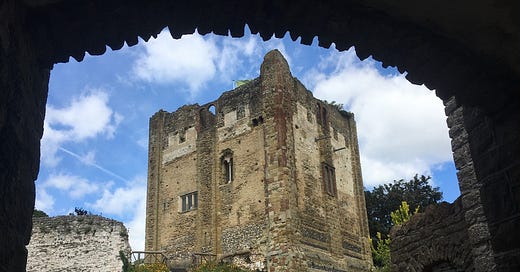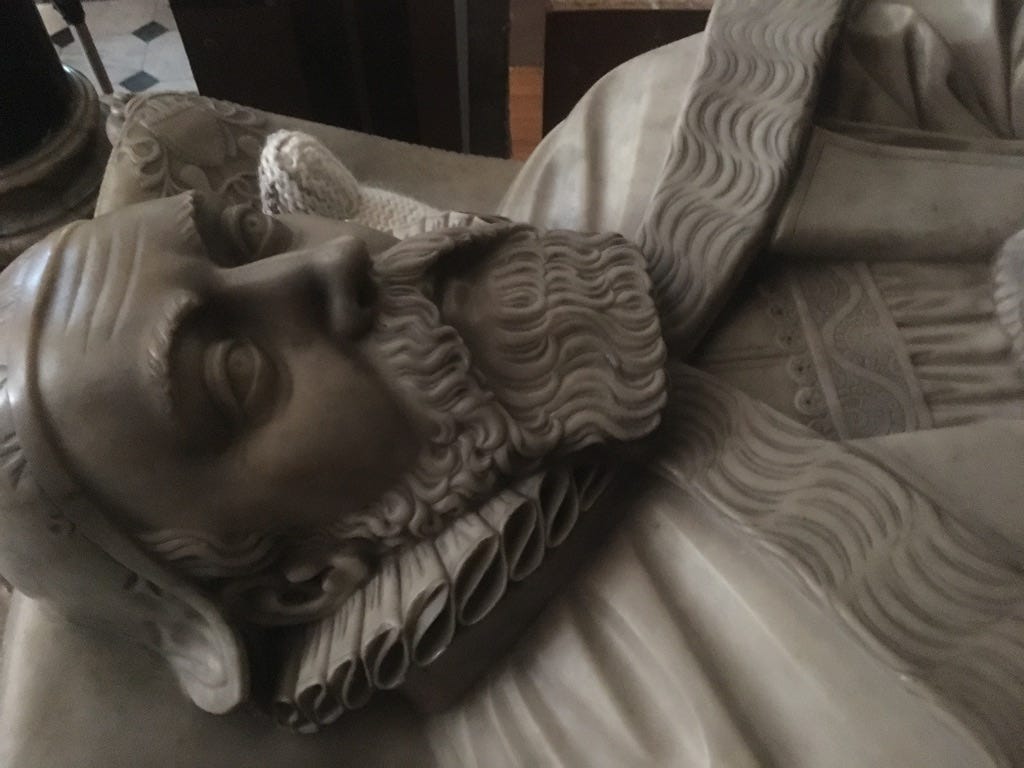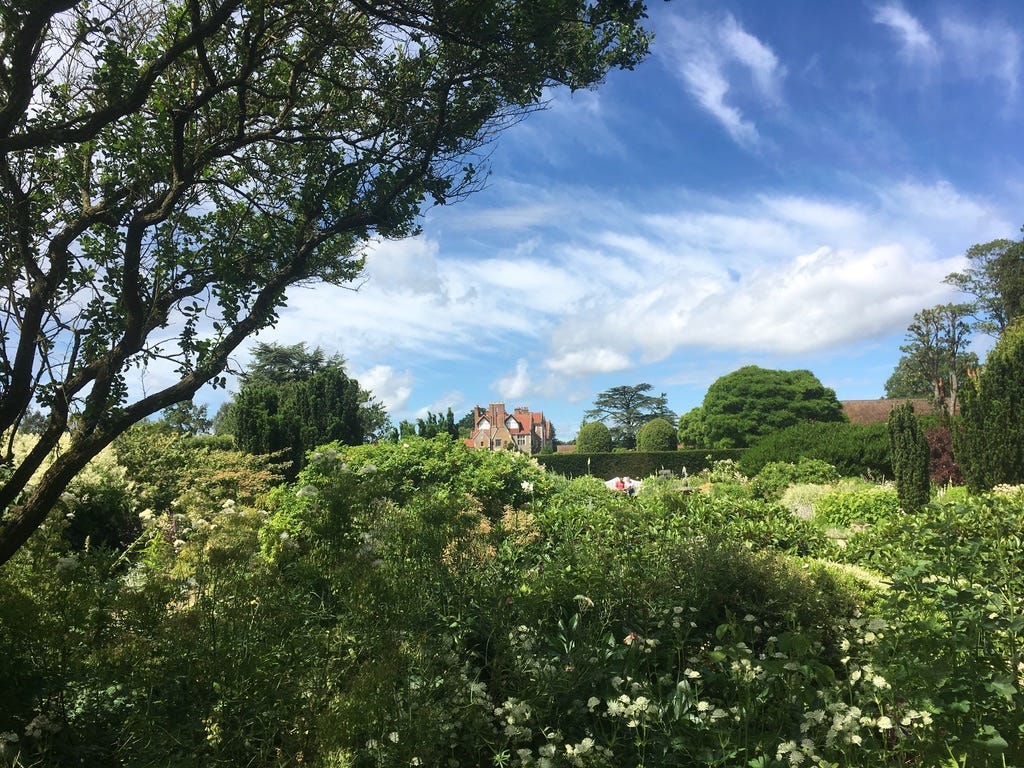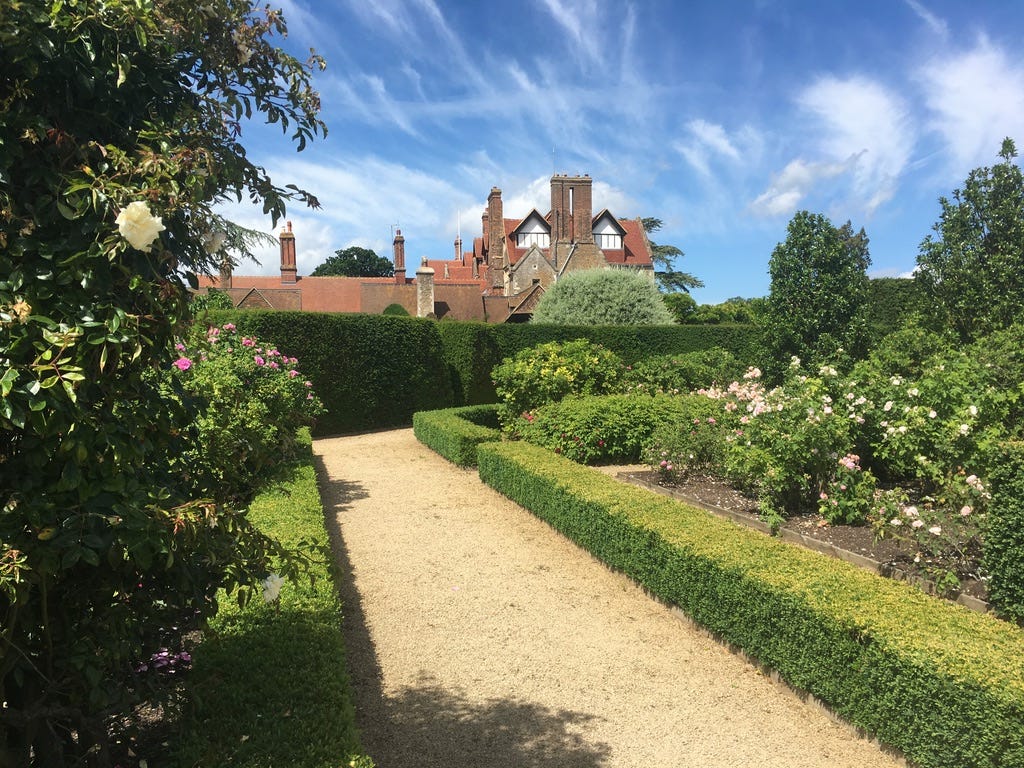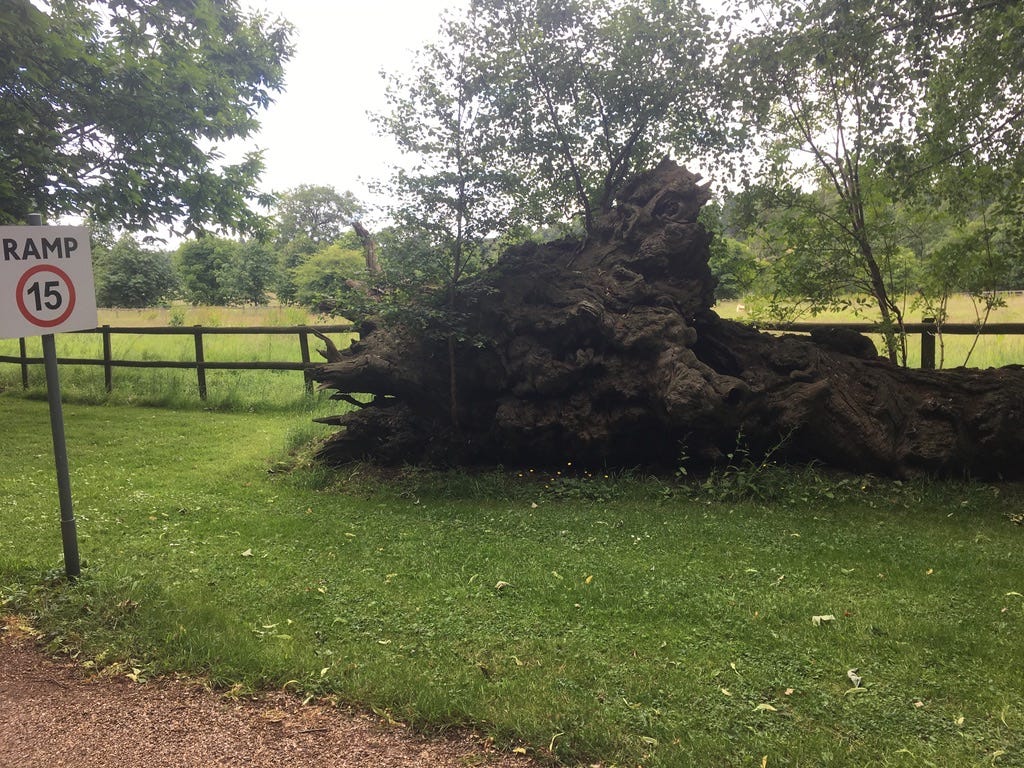Happy 2025 and thank you for being here! Before we go back in time, I want to issue
a formal apology.
I am about to relaunch the first chapter of my second Substack publication, Milady. After a steep learning curve the reissue will feature audio, and shorter chapters to help you enjoy the historical fiction you’ve been waiting for! Is that the sort of thing you expect from a serial?
And now back to Milady’s genesis story …from the beginning to invalid to …
June 2017
One thing our fictional Milady would certainly have seen on arrival in Guildford was the castle, now nearly a thousand years old. Probably begun just after 1066, the flints built into the walls of the Norman castle reminded me of Madrid’s use of flint in the walls around their castle, so that when arrows struck there would be sparks, thereby frightening the attackers. Flint is a common stone and looks nice striped into the mortar but how wonderful if sparks flew in Norman England.

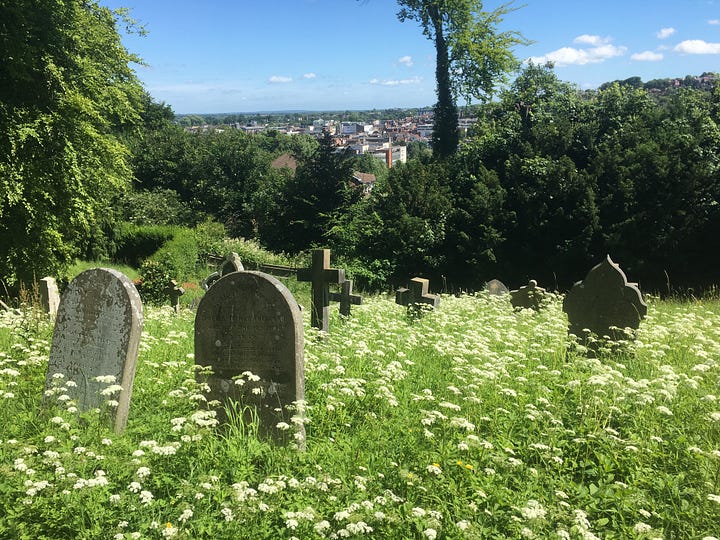
Dodgson’s grave in Guildford Cemetary
Charles Dodgson is Lewis Carrol and literature is well represented in Guildford. Somehow this place is familiar, if only through my mother’s stories. The cemetery is in a little churchyard with a winding path that leads right to the house where we used to live. I think of my parents’ hopes for us then. How my sister and I were to be sent to finishing school in Europe and educated to speak three or four languages. How shocked my parents would have been by Brexit.
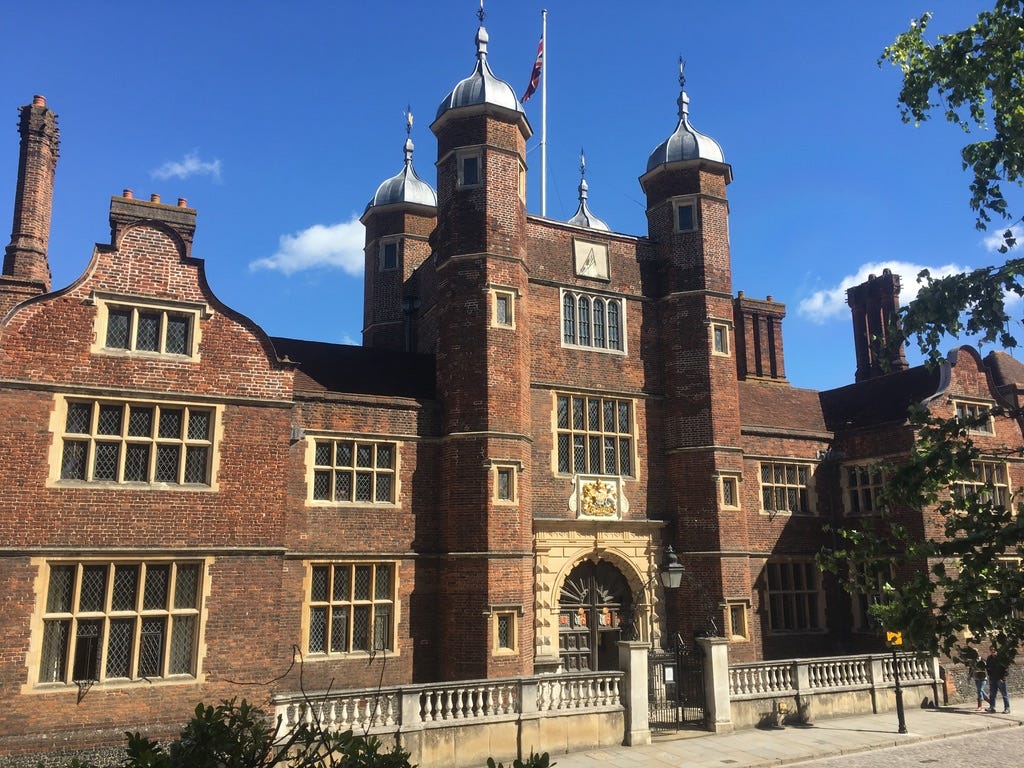
As I toured Guildford, I wondered if Milady might find work there? As wool was the mainstay, perhaps as spinner or weaver? It’s probable she worked with cloth in the nunnery. Or she learned in Guildford, practiced the craft and was discovered to be a girl by one of George Abbott’s six brothers? George’s father supposedly was a cloth worker. George Abbott was key into the court of James I, for sure. George Abbott, who was part of James’s translate-the-Bible team, was thought to be the only Archbishop ever to kill someone (until presumably 1980 when a man who had fought in WWII, Robert Runcie, was anointed). You can be sure Milady will get involved with Abbott’s scandal!
I commend historian Mary Alexander’s book, George Abbot’s Guildford if you’re interested in further details. George Abbot is planted in a rebuilt Trinity Church, opposite his hospital. His family are embossed on a brass plate. On my visit I found the church hosting yet another community get together - Saturday coffee. I could see small knitted sheep tucked in amongst the plaques and memorials for a children’s treasure hunt.
I met a woman in the bus drinking beer from a can. She might have been a sixties party girl but now had trouble walking, even with a stick. She wore gear more suitable for an evening out at a Tossa del Mar club: swishy, long, bluesy-swirl-floral frock and flip-flops with sparkles. Her lounging Irish accent slid out of a mouth barely open, difficult to understand her. It was 08:15 am when I left the house and, as she drank deeply from her can, she raised her little finger into the air. She had streaked blonde hair and sparkly light pink lipstick. She had twelve grandkids and five children. She used to live in Luton, oh, many different places, and, when they had holidays, she used to take the kids to the park with a picnic. She’d take ham sandwiches, (the children wouldn’t eat tomato), apples and an orange. They liked oranges. I had been surprised to see people drinking beer for breakfast in Munich but on a UK train, a chap in front of me downed a bottle of beer and what looked like a Jaegermaster - not a small bottle. When I changed to the next train I sat next to a young lady who quietly swallowed as much beer as she could get down her neck as fast as she could. Do you think British people drink more than the rest of the world?
My desire for health drives my sobriety. Health and control. Thinking of my body as the vehicle, I like to be fully in control. I do know the last drinks, maybe in 2010, went straight to my head and made me feel sick and stupid. Now I hate the smell and I can smell it metres away. I don’t want it in my life and I don’t miss it. Oh, I might think of a beer on a hot day - the idea of it at least - but so far I have not indulged.
When I left Blanes I reworked the letters on some beer stubbies as gifts (one of the teachers was called Miquel and he liked to be known as Mike). They looked quite good, I thought
Given I was surrounded by bottles of beer some gear shifted in my physical memory and at one moment I found I had reached out to drink - the shape of my hand curving to fit the bottle next to me - rather than the cup of tea one stop further over. I did not drink the beer.
The Lady of the Morning Drink was at the bus stop again. She was very well groomed, clean, but completely off her face at 08:15. This time she was dressed in a sparkly tee-shirt and groovy ripped and decorated jeans. She was draped with scarves and assorted accoutrements for a glamorous outing as well as her chilled bottle of white wine. I don’t think I ever drank alcohol for breakfast. And read it here, Brits really do drink more than anyone else. They probably did in the early seventeenth century too!
There’s a grand Manor House near Guildford, called Loseley Park. Elizabeth I stayed on several occasions while James I only stayed there once. Also, scenes from ‘Pride and Prejudice’ were filmed there.
Confounded by public transport on my way out of Guildford, I took a taxi to the main gate and a charming lady let me leave my pack in the little ticket office kiosk. I bought a cup of tea, and sat in the garden to nibble an apple and dried fruit while enjoying a gracious garden complete with ha ha before I joined the tour.
The front door would have opened onto the Great Hall, now featuring a portrait of James I looking annoyed. He has thin, pale hands. I like James’s air of impatience in the portrait. He seems to want to be off and about, not putting up with this posing nonsense. Wearing pale blue with the jewel of Union. Not sure James I is lauded enough for attempting the Union - starting with the first Union Jack flag for maritime purposes - and calling his regal lands the Kingdom of Great Britaine.
The ceiling includes the emblems of both families More and Molyneux; birds and symbols. The Great Drawing Room was built around a giant fireplace carved from (Blechly) chalk - the deep down harder stone. Very intricate carvings; patterns featuring several Green Men with their tongues out warding off evil spirits. On either side of the fireplace are two short chairs for the Ladies in Waiting.
There’s a Green Man on the ceiling in the King’s Chamber together with the thistle and the Tudor rose. I wonder what Anne would have made of all these Green Men poking out their tongues? There were Green Men across Europe. I wonder if there are any left in the real trees and forests?
In the library, the Elizabethan coat of arms - she stayed at least four times after requiring her favourite William to create a suitable place for her to stay - the lion rampant and the dragon of Wales. Not ‘til James I did the unicorn arrive. All extinct creatures.
The house faces North, to avoid the prevailing winds which might bring the plague. The Queen wanted a cosy room facing west so she could have sun in the afternoon.
It is tranquil in the garden. A large fallen mulberry tree on the driveway might have been planted by Queen Elizabeth. The house has a number of family mottos about the mulberry tree such as:
the tree dies slowly, the fruit die fast.
In 1609 James I ordered ten thousand mulberry trees to be planted in London for silk cultivation. Unfortunately, he planted black mulberries, not the silkworm’s favourite, white. Some say it was the fiendish French who led him astray. Sadly, it was before Anne’s time or I can assure you, Milady would certainly have advised the King most sincerely and possibly, just a little fiendishly!

